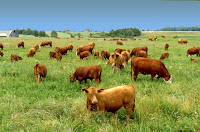Where’s the Grass-fed Beef? by Elizabeth Brown, MS, RD
 To eat beef or not to eat beef?
To eat beef or not to eat beef?
While walking through my favorite grocery store, I overheard the guy at the meat counter tell a customer that their organic, free-range beef was raised on a mixed grass and grain diet. Although I eat red meat infrequently, I thought I was buying a good source from this supplier. I have also bought grass-fed beef at the farmer’s market, but you have to buy a pound at a time which is frozen and therefore difficult to break into smaller portions for rationing.
The downfall of grain-fed beef is that it is more likely to contain harmful E. coli than beef from grass-fed cattle. According to research microbiologist James B. Russell, cattle are fed grain to help increase their growth rate, but being fed a diet rich in grains instead of grass can disrupt normal physiology. For one thing, grain-based diets are lower in beneficial fiber than grass-fed diets.
Grain-based diets allow fermentation acids to accumulate in the rumen, one of the four stomachs of a ruminant animal. The rumen serves as a vat where microorganisms, including “good bacteria,” feed off of dietary fiber and therefore aid fiber digestion. In turn, these microorganisms supply the cattle with useful protein, vitamins and short-chain organic fatty acids. Without adequate fiber, these acids are not absorbed efficiently leading to acid buildup and resulting in ulcers. Infectious bacteria pass from the rumen through the ulcers to the blood stream and finally to the liver where they cause abscesses. The animal is then given antibiotics causing further disruption to their symbiotic microbial ecosystem.
Ruminant animals lack the digestive enzymes to break down grains. This can lead to the overgrowth of Clostridium perfringens, potentially deadly to the animal. There is also risk of an increased growth of a harmful strain of E. coli in the digestive tract. This particular strain of E. coli, 0157:H7, are resistant to stomach acid. When this E. coli contaminates ground beef, it can lead to illness and even death in certain populations. Cattle switched from grain-based diets to hay or grass are less likely to produce harmful E. coli.
My foray into the world of grass versus grain-fed beef began after reading a story about a woman who became paralyzed from that harmful E. coli. She ate a contaminated burger and five days later she was in a coma. When she awoke nine weeks later, she could no longer walk.
Food safety may be a big reason people are opting for more vegetarian meals. Vegetarian diets offer myriad health benefits over a diet rich in animal protein. However, when following a strict vegetarian diet, it can be difficult to meet all of your nutrient needs. If you choose to go vegetarian or vegan, make an extra effort to ingest adequate sources of protein, B12, iron, zinc, calcium and vitamin D or supplement appropriately.
I like fortified nutritional yeast flakes for B12; beans, spinach and dried fruit for iron; almond or soy milk also for B12 as well as calcium and vitamin D. Zinc is a bit tougher to get in a vegetarian diet, but one cup of beans provides up to 1/3 of the recommended intake. Protein is found in beans and grains. If you still want an occasional beef burger, this recipe works well to extend the use of your more costly but much safer grass-fed beef. Simply mix these ingredients with your grass-fed beef and enjoy the wonderful health benefits of eating a semi-vegetarian diet.
4 cups water
1/4 cup water
1 cup cooked brown rice
2 slices gluten free bread toasted and processed into crumbs or 1/2 cup bread crumbs
1/4 cup nutritional yeast flakes
2 teaspoons Dijon mustard
Cook beans on the stove top or Crockpot with water and bay leafs. In a food processor, combine cooked, drained beans with flax seed and water. Puree until blended but still lumpy. Add remaining ingredients except barbeque sauce. Pulse until blended. Place in bowl and cover and chill in refrigerator at least 2 hours. Preheat oven to 350 degrees F. When ready to cook burgers, shape into eight patties and place on an oiled cookie sheet. Baste burgers with barbeque sauce and bake 1 hour. Carefully flip and baste burgers every 15 minutes for a crispy coating.
(Recipe adapted from The Crispy Cook, a wheat-free, meat-free blog)
Per serving: 228 calories, 12g protein, 30g carbs, 9g fiber, 7g fat, 1190mg Omega-3 fats. High in every nutrient except vitamins C, D and E.
